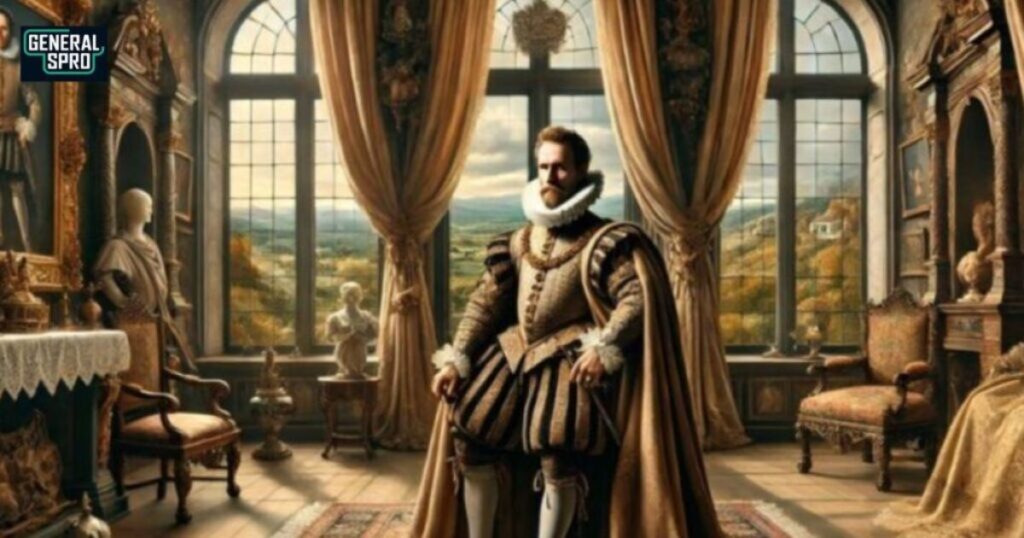The Renaissance period in Germany represented a transformative era of artistic and intellectual awakening, where portraiture emerged as a powerful medium of personal and cultural expression. The 1555 portrait of Heinrich Servais stands as a remarkable testament to the sophisticated visual narratives cultivated during this dynamic epoch. Emerging from the rich cultural landscape of mid-16th century Germany, this portrait encapsulates the intricate interplay between individual identity and the broader artistic movements of the time. The meticulous detail and profound symbolic elements embedded within the artwork reflect the humanistic values characteristic of Renaissance thought.
Heinrich Servais, a prominent figure within the German intellectual and social circles of the mid-16th century, personified the Renaissance ideal of the multifaceted individual. The portrait captures not merely his physical likeness, but also communicates his social standing, intellectual pursuits, and personal achievements through carefully orchestrated visual symbolism. The artist’s commitment to realism, combined with subtle allegorical representations, demonstrates the Renaissance aesthetic of presenting individuals as complex, dignified entities. Clothing, posture, and background elements were strategically employed to convey Servais’s scholarly status, familial lineage, and personal philosophical perspectives.
The historical significance of this 1555 portrait extends far beyond its immediate visual impact, serving as a critical document of German Renaissance culture. It provides contemporary scholars with invaluable insights into the social structures, artistic techniques, and intellectual frameworks of 16th-century Germany. The portrait’s preservation and continued scholarly examination underscore Heinrich Servais’s enduring legacy as a representative figure of his time. Through its nuanced composition and sophisticated execution, the artwork becomes more than a mere representation—it transforms into a profound historical narrative, capturing the essence of an individual while simultaneously reflecting the broader cultural and intellectual currents of the Renaissance period.
1555 Portrait Servais Germany: Capturing the Impact of a Renaissance Scholar

The portrait transcends traditional representation, becoming a complex dialogue between art, intellect, and historical context. Heinrich Servais stands as a quintessential Renaissance intellectual, embodying the period’s commitment to knowledge, personal growth, and societal advancement. The artwork meticulously captures the nuanced layers of his character, revealing the depth of Renaissance humanism through every carefully rendered detail.
Masterful Techniques
Chiaroscuro emerges as the defining artistic technique in this extraordinary portrait. This sophisticated method of light and shadow manipulation transforms the artwork from a simple representation to a profound psychological exploration. The artist’s masterful approach creates extraordinary depth, allowing Servais’s inner world to emerge through subtle gradations of light. Each brushstroke becomes a deliberate communication, revealing not just physical characteristics but the intricate landscape of an intellectual’s mind.
Symbolic Elements
Every element within the portrait carries profound symbolic significance. The carefully positioned books, intricate scientific instruments, and subtle background details speak volumes about Servais’s intellectual pursuits. Rich color palettes of deep blues and vibrant reds transcend mere aesthetic choices, representing complex statements about social status, intellectual achievement, and cultural sophistication. These symbolic elements transform the portrait from a simple visual representation into a rich narrative of Renaissance intellectual life.
Capturing Character
The true mastery of the portrait lies in its unprecedented ability to capture Servais’s inner essence. His expression transcends mere physical likeness, revealing an intricate inner landscape of contemplation, determination, and intellectual passion. This approach perfectly embodies the Renaissance ideal of celebrating individual human potential, presenting Servais not just as a historical figure, but as a complex, multifaceted human being.
Honoring Heinrich Servais
Heinrich Servais emerged as a transformative figure in 16th-century German education, challenging existing intellectual and social paradigms. His visionary approach extended far beyond traditional learning models, advocating for accessible education that could empower individuals and fundamentally transform societal structures. Servais understood education as a powerful mechanism for individual and collective advancement.
Educational Reforms
Servais championed educational reforms that were radical and progressive for his time. He fundamentally believed that knowledge should not remain confined to elite intellectual circles but distributed broadly across social strata. His approach challenged hierarchical educational structures, promoting intellectual empowerment as a fundamental human right. By advocating for broader access to learning, Servais laid critical groundwork for future public education systems.
Civic Engagement
Beyond academic pursuits, Heinrich Servais demonstrated profound commitment to civic advancement. He recognized education as a transformative tool for community development, encouraging critical thinking and active societal participation. Servais understood that an informed, educated population could drive meaningful social progress, bridging gaps between different social classes and promoting collective intellectual growth.
Intellectual Legacy
The intellectual legacy of Heinrich Servais extends far beyond his immediate historical context. His holistic approach to learning, emphasizing creativity, critical thinking, and interdisciplinary understanding, would influence academic institutions for generations. Servais represented a crucial bridge between medieval traditions and emerging Renaissance philosophies, embodying the period’s commitment to intellectual exploration and personal growth.
Read Also This Article : Dallas Mavericks vs Timberwolves Match Player Stats Analysis
The Legacy of Heinrich Servais

The portrait captures the nuanced socio-political landscape of mid-16th-century Germany, reflecting the profound religious and intellectual tensions of the Protestant Reformation. It presents a visual narrative of a society in remarkable transformation, where traditional structures were being fundamentally challenged and reimagined.
Reflection of Religious Upheaval
While not overtly religious, the portrait subtly hints at the spiritual and intellectual tensions of the era. The Protestant Reformation had dramatically reshaped societal norms, creating an environment of unprecedented intellectual and spiritual questioning. Servais’s portrait becomes a silent yet powerful commentary on these complex dynamics, representing the intellectual negotiation between traditional religious structures and emerging philosophical perspectives.
Intellectual Ferment
The artwork represents an era of unprecedented intellectual exploration. Scientific reasoning, philosophical inquiry, and artistic innovation converged, creating a dynamic environment of constant questioning and discovery. This period marked a critical transition where traditional knowledge systems were being critically examined and reconstructed.
Bridging Traditions
The portrait beautifully illustrates the transition from medieval artistic conventions to Renaissance innovations. It masterfully balances traditional representational techniques with emerging humanist perspectives, symbolizing the broader cultural metamorphosis occurring throughout Europe. This artwork becomes a visual metaphor for the intellectual and artistic transformation of the era.
Read Also This Article : Grand Film Productions NYT
Contextualizing the Artistic Masterpiece
The portrait exists at a critical historical intersection, where artistic representation met intellectual discourse. Created in 1555, during the height of the Protestant Reformation, this artwork serves as a visual chronicle of a society in profound transition. Heinrich Servais stands not just as an individual, but as a representative of an entire generation of scholars challenging existing intellectual boundaries.
Renaissance Portraiture
The chiaroscuro technique employed in this portrait represents the pinnacle of artistic sophistication. Light and shadow interplay with remarkable complexity, creating depth that transcends two-dimensional representation. Each subtle gradation reveals not just physical features but the intricate psychological landscape of Heinrich Servais. The artist’s technical prowess transforms the portrait from a simple likeness into a profound psychological study.
Symbolic Language of Renaissance Art
Every element within the portrait carries multilayered symbolic significance. The carefully positioned books, scientific instruments, and nuanced background details communicate far more than visual aesthetics. Rich color palettes of deep blues and vibrant reds represent complex social hierarchies, intellectual achievements, and cultural sophistication. These symbolic elements transform the artwork into a rich narrative of Renaissance intellectual life.
Capturing Individual Essence
The portrait’s true brilliance lies in its unprecedented ability to capture Servais’s inner complexity. Beyond physical representation, the artwork reveals an intricate landscape of intellectual passion, contemplation, and profound determination. This approach perfectly embodies Renaissance humanism, celebrating individual human potential and challenging existing representational conventions.
Read Also This Article : Premakante Family ki Viluva Iche Vadu
Heinrich Servais
Heinrich Servais emerged as a transformative figure in 16th-century German intellectual circles. His vision extended far beyond traditional academic boundaries, advocating for educational approaches that could fundamentally reshape societal structures. Servais understood knowledge not as a privilege, but as a powerful mechanism for individual and collective empowerment.
Educational Philosophy
Servais’s educational reforms were radical for his time. He challenged existing hierarchical educational structures, proposing learning models that promoted broad intellectual access. By arguing that knowledge should transcend elite circles, he laid critical groundwork for future public education systems. His philosophy emphasized critical thinking, creativity, and holistic understanding.
Civic Engagement and Social Transformation
Beyond academic pursuits, Heinrich Servais demonstrated profound commitment to societal advancement. He recognized education as a transformative tool for community development, encouraging active civic participation and intellectual discourse. Servais understood that an informed population could drive meaningful social progress, bridging complex social divisions.
Intellectual Legacy and Interdisciplinary Vision
Servais’s intellectual legacy extends far beyond his immediate historical context. His approach to learning emphasized interconnected knowledge, challenging disciplinary boundaries. By promoting creativity and critical thinking, he influenced academic institutions for generations, representing a crucial bridge between medieval traditions and emerging Renaissance philosophies.
Read Also This Article: Exploring the Slayunny2 Phenomenon
Historical Landscape

The portrait captures the nuanced socio-political complexity of mid-16th-century Germany. Set against the backdrop of the Protestant Reformation, it represents a society undergoing profound intellectual and spiritual transformation.
Religious and Intellectual Tensions
The artwork subtly reflects the spiritual and intellectual tensions of the era. The Protestant Reformation had dramatically reshaped societal norms, creating an environment of unprecedented questioning and philosophical exploration. Servais’s portrait becomes a silent yet powerful commentary on these complex dynamics.
Intellectual Ferment and Revolutionary Thinking
This period represented an extraordinary convergence of scientific reasoning, philosophical inquiry, and artistic innovation. Traditional knowledge systems were critically examined, reconstructed, and reimagined. The portrait embodies this spirit of intellectual revolution, capturing a moment of profound cultural metamorphosis.
Artistic Transition
The artwork beautifully illustrates the transition from medieval artistic conventions to Renaissance innovations. By masterfully balancing traditional representational techniques with emerging humanist perspectives, the portrait becomes a visual metaphor for broader cultural transformation.
Read Also This Article : The Legacy of the Honngen Civil War Sword
Preservation and Contemporary Significance
Modern conservation efforts ensure that this remarkable artwork continues communicating its rich historical narrative. Advanced technological interventions allow researchers to explore hidden layers, revealing previously unknown details about the artwork’s creation and historical context.
Conservation as Scholarly Practice
Contemporary art preservation represents a sophisticated intersection of technological innovation and historical scholarship. Multispectral imaging, digital restoration techniques, and scientific analysis help unlock complex narratives embedded within historical artifacts.
Educational and Cultural Value
The portrait serves as a powerful educational tool, offering tangible connections to historical periods. It allows contemporary audiences to engage directly with Renaissance culture, bridging temporal and cultural divides, and providing insights into human intellectual potential.
Read Also This Article : Jiniphee OnlyFans Leak
Frequently Asked Questions
Who was Heinrich Servais?
Heinrich Servais was a prominent 16th-century German intellectual who made significant contributions to education and civic life during the Renaissance period. He was a scholar and reformer who advocated for accessible education and intellectual empowerment.
What makes the 1555 Portrait Servais Germany significant?
The portrait is a remarkable Renaissance artwork that goes beyond mere representation, capturing the intellectual essence of Heinrich Servais. It exemplifies Renaissance artistic techniques like chiaroscuro and provides deep insights into the cultural and intellectual landscape of mid-16th century Germany.
How does the portrait reflect Renaissance ideals?
The artwork embodies Renaissance humanism through its focus on individual character, detailed realism, and symbolic representation. It highlights individualism, intellectual pursuits, and the period’s emphasis on human potential and personal achievement.
What historical context surrounds the 1555 Portrait?
Created during the Protestant Reformation, the portrait reflects the turbulent intellectual climate of 16th-century Germany. It captures the transition between medieval traditions and Renaissance innovations, serving as a visual narrative of significant social and cultural transformations.
Why is art conservation important for this portrait?
Art conservation ensures that historical artifacts like this portrait can continue to communicate their rich narratives. Modern technological interventions allow researchers to explore hidden layers, reveal unknown details, and preserve critical insights into Renaissance cultural heritage.
Conclusion
The 1555 Portrait Servais Germany transcends its historical moment, offering a profound meditation on human potential, intellectual curiosity, and cultural transformation. It reminds us that art is never merely a representation, but a complex dialogue bridging past and present.
Heinrich Servais emerges not just as a historical figure, but as a testament to the enduring power of human intellect and creativity. His portrait continues to inspire, challenge, and illuminate our understanding of cultural evolution, serving as a timeless exploration of the human spirit’s extraordinary capacity for growth and discovery.

Admin Account for ZenithFlares.com—offering insightful and up-to-date content across a range of popular topics, designed to keep readers informed, entertained, and engaged daily.
